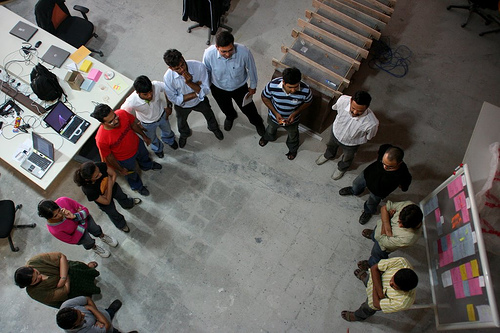
OK, they’re all standing, but you don’t have to. This is what a Sync-Up looks like.
When I first accepted my job as an Instructional Media Developer at GCC, I was coming from a web development environment that had embraced the idea of the Daily Stand-Up. Nothing did more to help me feel like I was part of something bigger than myself than those daily, lightning-fast meetings my team held to check in with one another. In my new role, I immediately missed this sense of working together toward a shared goal. I felt alone in a silo.
If I could bring anything from the outside world into the Maricopa Community Colleges, it would be a regular Sync-Up. (Literally standing up is difficult or impossible for some people, so I don’t want to call it a Stand-Up. And for some of our teams or committees, daily is too much.) But being truly accountable to and in sync with your coworkers is something I still miss from my last job.
So what is a Sync-Up? It’s a very short meeting, no more than 15 minutes. The people doing the work are the ones who speak, though interested parties might attend as observers. Each contributing person provides 3 pieces of information when it’s their turn to speak:
- What they’ve accomplished toward shared goals since the last Sync-Up
- What they commit to accomplishing between now and the next Sync-Up
- Any obstacles they foresee that could get in the way
When not speaking it’s everyone’s job to listen closely. Specifically, to listen for points of connection to your own work, and for areas where you may be able to help. If you can help remove someone else’s obstacle you let them know, and then you’ll both collaborate after the Sync-Up – you don’t derail the meeting discussing the solution while everyone waits.
This is not a status report. Each person considers the audience – the rest of their team – and makes sure they discuss accomplishments, plans, and obstacles in a way that is meaningful to their team. The purpose is to assure that each team member’s activity is aligned and progressing the team as a whole toward successful and timely completion of their goal. In my experience, it’s empowering to Sync-Up daily when a team is working together on a well-defined project.
This is not a planning meeting where a team breaks down all the steps to complete a project. That type of planning meeting usually needs more than 15 minutes. But once you’ve laid out the tasks that need to be done to achieve a goal, regular Sync-Ups are magic for keeping your group energized and on task.
This is what regular Sync-Ups can accomplish (from Bill Hoberecht of Pinnacle Projects in his post The Daily Stand-Up Meeting – A Core Practice for Self-Organizing Teams):
- An explicit reinforcement of the commitment by each team member to accomplish a goal
- A means of dynamically adjusting the work by each team member to accomplish the goal
- A daily synchronization between team members, informing team mates of work activities, progress and issues
- A method of cross-checking progress with team mates
- An accountability mechanism that has each team member accountable to other team members for their responsibilities
- A visible demonstration of the ability of the team to self-manage their project responsibilities
The main benefit I experienced from the Sync-Up meeting style was confidence. I was confident I knew what was going on with my team and our shared goals. I was certain what I should be doing next. I knew who could and would help me out of a jam. I knew how my efforts fit into the whole. I was positive my workgroup would succeed, and I usually knew exactly when we’d achieve our goal. I knew my work was valued. I knew what my teammates needed and how I could help.
I miss feeling this way every week and hope to find ways of recapturing this sense of shared purpose within my GCC community of collaborators.
